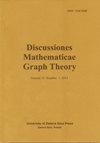The Hilton-Spencer Cycle Theorems Via Katona’s Shadow Intersection Theorem
IF 0.8
4区 数学
Q3 MATHEMATICS
引用次数: 0
Abstract
Abstract A family 𝒜 of sets is said to be intersecting if every two sets in 𝒜 intersect. An intersecting family is said to be trivial if its sets have a common element. A graph G is said to be r-EKR if at least one of the largest intersecting families of independent r-element sets of G is trivial. Let α (G) and ω (G) denote the independence number and the clique number of G, respectively. Hilton and Spencer recently showed that if G is the vertex-disjoint union of a cycle C raised to the power k and s cycles 1C, . . ., sC raised to the powers k1, . . ., ks, respectively, 1 ≤ r ≤ α (G), and min(ω(C1k1),…,ω(Csks))≥ω(Ck), \min \left( {\omega \left( {{}_1{C^{k1}}} \right), \ldots ,\omega \left( {{}_s{C^{ks}}} \right)} \right) \ge \omega \left( {{C^k}} \right), then G is r-EKR. They had shown that the same holds if C is replaced by a path P and the condition on the clique numbers is relaxed to min(ω(C1k1),…,ω(Csks))≥ω(Pk), \min \left( {\omega \left( {{}_1{C^{k1}}} \right), \ldots ,\omega \left( {{}_s{C^{ks}}} \right)} \right) \ge \omega \left( {{P^k}} \right), We use the classical Shadow Intersection Theorem of Katona to obtain a significantly shorter proof of each result for the case where the inequality for the minimum clique number is strict.Hilton—Spencer循环定理与Katona的阴影交定理
如果一个集合族中的每两个集合都是相交的,就说它们是相交的。如果一个相交族的集合有一个公共元素,我们就说它是平凡族。如果图G的独立的r元素集合的最大相交族中至少有一个是平凡的,则称图G为r-EKR。设α (G)和ω (G)分别表示G的独立数和团数。Hilton和Spencer最近证明,如果G是一个循环C的k次方和s个循环1C,…,sC的k1,…,ks次方的顶点不相交并,分别为1≤r≤α (G),并且min(ω(C1k1),…,ω(Csks))≥ω(Ck), \min\left ({\omega\left (_1C^k1 {{}{{}}}\right), \ldots,\omega\left (_sC^ks {{}{{}}}\right) }\right) \ge\omega\left (C^k {{}}\right),则G为r-EKR。他们已经证明,如果用路径P代替C,并且将团数的条件放宽为min(ω(C1k1),…,ω(Csks))≥ω(Pk), \min\left ({\omega\left (_1C^k1 {{}{{}}}\right), \ldots, \omega\left (_sC^ks {{}{{}}}\right) }\right) \ge\omega\left (P ^k {{}}\right),对于最小团数不等式严格的情况,我们利用经典的卡托纳阴影交定理,得到了每个结果的较短的证明。
本文章由计算机程序翻译,如有差异,请以英文原文为准。
求助全文
约1分钟内获得全文
求助全文
来源期刊

Discussiones Mathematicae Graph Theory
MATHEMATICS-
CiteScore
2.20
自引率
0.00%
发文量
22
审稿时长
53 weeks
期刊介绍:
The Discussiones Mathematicae Graph Theory publishes high-quality refereed original papers. Occasionally, very authoritative expository survey articles and notes of exceptional value can be published. The journal is mainly devoted to the following topics in Graph Theory: colourings, partitions (general colourings), hereditary properties, independence and domination, structures in graphs (sets, paths, cycles, etc.), local properties, products of graphs as well as graph algorithms related to these topics.
 求助内容:
求助内容: 应助结果提醒方式:
应助结果提醒方式:


